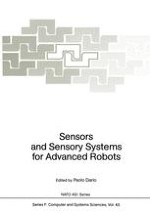1988 | OriginalPaper | Buchkapitel
Multimedia Sensory Systems for the Solution of the Error Recovery Problem
verfasst von : V. Caglioti, R. Simino, M. Somalvico
Erschienen in: Sensors and Sensory Systems for Advanced Robots
Verlag: Springer Berlin Heidelberg
Enthalten in: Professional Book Archive
Aktivieren Sie unsere intelligente Suche, um passende Fachinhalte oder Patente zu finden.
Wählen Sie Textabschnitte aus um mit Künstlicher Intelligenz passenden Patente zu finden. powered by
Markieren Sie Textabschnitte, um KI-gestützt weitere passende Inhalte zu finden. powered by
The advanced role of sensory systems is very important in intelligent assembly robots.Two special-purpose techniques are developed for sensory perception and planning, by exploiting the particularity of the problem they are meant to deal with:to provide a robot with both the capability in understanding the causes of errors in its activity and the capability in correcting the error situation and in recovering its fully operational functionality.A robot, while is executing a working cycle, may be stopped within an assembly process by an error caused by a defective object, by a wrongly positioned object, by the absence of an object, or by an unpredicted collision between objects.Therefore, when such unpredicted (and undesired) events happen, the correct execution of the cycle may be compromised or even stopped. Sensors can then be utilized to extract knowledge about the actual (error) situation. This knowledge can then be employed in order to plan the correction of the occurred error.In the sequel, we shall call this set of activities as the activity of error recovery.The purpose of this paper is to show how the integration of multimedia sensory data may become functional for the solution of the automatic error recovery probIem.Before a planning a strategy intended to error recovery, the elements to be considered within the planning problem have first to be identified. These elements are: the starting state (in this case the error state);the target state, which has to be determined according to the task, that is assigned to the robot.Therefore a comprehensive correcting activity can be arranged along three phases: 1.the deduction of the task, starting from the assigned program and from possible further information;2.the detection of the error situation, through the use of sensors;3.planning a correcting strategy, whose execution allows the correct accomplishment of the robot task, in spite of the error that has occurred.Our approach is based on the the adoption of a three-modules architecture. 1.A first (off-line) module, starting from the program assigned to the robot and using some knowledge about physical and geometrical features of the objects, makes a knowledge based task deduction, via a simulation of the program execution (“dynamic” action’s analysis), in order to provide a wide representation of the desired evolving world state (in terms of positions, contacts, and constraints among the objects).2.A second (on-line) module, after an error has occurred, plans a dynamic sequence of sensory detections, in order to acquire a sufficient amount of knowledge to construct a useful description of the actual (error) situation. The attribute “dynamic” refers here to the fact that the next sensory detection of the sequence depends on the current world model, that has been constructed exploiting the result of the current sensory detection.3.A third (on-line) module plans a correcting strategy, using as starting state the description of the error state (provided by the second module), and using as target state one of the desired evolving states (provided by the task deduction module).This approach allows to reduce the weaknesses indicated above, but has the drawback of a supplementary processing charge, especially during the task deduction activity.However, the fact that the task deduction is executed off-line reduces the importance of this shortcoming.
